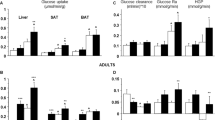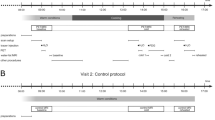Abstract
BACKGROUND: Adipose tissue metabolism can be investigated directly in vivo by microdialysis and indirectly in vitro using isolated adipocytes. The in vitro studies are relatively easy to make and they give information about specific tissue metabolism. The in vivo studies, on the other hand, are supposed to give relevant data about tissue physiology interacting with other metabolic systems at the body level.
OBJECTIVE: To investigate the concordance between the results on responsiveness to stimulation of lipolysis from in vivo microdialysis and in vitro isolated adipocytes.
SUBJECTS: Altogether 22 massively obese otherwise healthy subjects (seven men and 15 women, age 41 (26–55) y, BMI 51.5 (37.5–73.9) kg/m2, mean (range)) going through the gastric banding operation participated in the study.
METHODS: The microdialysis study was done after an overnight fast at rest. Lipolysis was stimulated with isoprenaline that was perfused into the subcutaneous abdominal adipose tissue. Local blood flow was estimated by ethanol dilution method. Adipose tissue biopsy for the in vitro study was taken from subcutaneous abdominal region during the operation. Lipolysis in freshly isolated adipocytes was stimulated with different concentrations of adrenaline or isoprenaline.
RESULTS: Significant positive correlations were observed between the values of relative stimulation of lipolysis in isolated adipocytes and in the microdialysis study. These correlations improved after correcting for cell size or fat mass.
CONCLUSION: The microdialysis study in vivo and lipolysis assay with isolated adipocytes in vitro provide concordant and complementary information of adipose tissue metabolism in the same individual.
This is a preview of subscription content, access via your institution
Access options
Subscribe to this journal
Receive 12 print issues and online access
$259.00 per year
only $21.58 per issue
Buy this article
- Purchase on Springer Link
- Instant access to full article PDF
Prices may be subject to local taxes which are calculated during checkout



Similar content being viewed by others
References
Hotamisligil GS, Shargill NS, Spiegelman BM . Adipose expression of tumor necrosis factor-α: direct role in obesity-linked insulin resistance Science 1993 259: 87–91.
Sniderman AD, Cianflone K . The adipsin–ASP pathway and regulation of adipocyte function Ann Med 1994 26: 388–393.
Lönnqvist F, Arner P, Nordfors L, Shalling M . Overexpression of the obese (ob) gene in adipose tissue of human obese subjects Nature Med 1995 1: 950–953.
Spiegelman BM, Flier JS . Adipogenesis and obesity: rounding out the big picture Cell 1996 87: 377–389.
Bray GA, York DA . Leptin and clinical medicine, a new piece in the puzzle of obesity J Clin Endocrinol Metab 1997 82: 2771–2776.
Lillioja S, Foley J, Bogardus C, Mott D, Howard BV . Free fatty acid metabolism and obesity in man: in vivo in vitro comparisons Metabolism 1986 35: 505–514.
Ohisalo JJ, Ranta S, Huhtaniemi IT . Attenuated R-site effect in human adipocytes in obesity Metab Clin Exp 1986 35: 143–146.
Ohisalo JJ, Milligan G . Guanine nucleotide binding proteins Gi and Gs in adipocytes plasma membranes of normal, hypothyroid and obese human subjects Biochem J 1989 260: 843–847.
Martin LF, Klim CM, Vannucci SJ, Dixon LB, Landis JR, LaNoue KF . Alterations in adipocyte adenylate cyclase activity in morbidly obese and formely morbidly obese humans Surgery 1990 108: 228–235.
Coon P, Greenberg AS, Goldberg AP, Londos C . Regional and obesity-linked differences in adenylyl cyclase-linked receptor signalling in human adipocytes J Cell Biochem Suppl 1991 15: 23.
Kaartinen JM, LaNoue KF, Martin LF, Vikman H-L, Ohisalo JJ . β-adrenergic responsiveness of adenylate cyclase in human adipocyte plasma membranes in obesity and after massive weight reduction Metabolism 1995 44: 1288–1292.
Arner P . Regulation of lipolysis in fat cells Diabetes Rev 1996 4: 450–463.
Jensen MD . Lipolysis: contribution from regional fat Annu Rev Nutr 1997 17: 127–139.
Arner P . Catecholamine-induced lipolysis in obesity Int J Obes Relat Metab Disord 1999 23 (Suppl 1): 10–13.
Leibel RL, Edens NK . Control of acylglyceride stores in human adipose tissue: re-esterification and lipolysis. Comparability of in vivo and in vitro findings. In Obesity: Towards a Molecular Approach New York: Liss 1990, pp 189–201.
Carey GB . Mechanisms regulating adipocyte lipolysis. In: Richter et al (eds) Skeletal Muscle Metabolism in Exercise and Diabetes New York: Plenum Press 1998, pp 157–170.
Arner P . Techniques for the measurements of white adipose tissue metabolism: a practical guide Int J Obes Relat Metab Disord 1995 19: 435–442.
Lafontan M, Arner P . Application of in situ microdialysis to measure metabolic and vascular responses in adipose tissue Trends Pharmacol Sci 1996 17: 309–313.
Kather H, Wieland E . Glycerol, luminometric method. In Methods of Enzymatic Analysis, Vol 6, Bergmeyer (ed). Wernheim: Verlag 1984, pp 510–519.
Arner P, Kriegholm E, Engefeldt P . In situ studies of catecholamines-induced lipolysis in human adipose tissue using microdialysis J Pharm Exp Ther 1990 254: 284–288.
Jansson P-A . Microdialysis of human subcutaneous tissue. A new technique to study fat cell metabolism in situ. Academic dissertation University of Göteborg, Göteborg, Sweden 1991.
Hickner RC, Rosdahl H, Borg I, Ungestedt U, Jorfeldt L, Henricksson J . Ethanol may be used with the microdialysis technique to monitor local blood flow changes in skeletal muscle: dialysate glucose concentration is blood-flow-dependent Acta Physiol Scand 1991 143: 355–356.
Ohisalo JJ, Kaartinen JM, Ranta S, Mustajoki P, Hreniuk S, LaNoue KF, Martin LF . Weight loss normalizes the inhibitory effect of N6-(phenylisopropyl)-adenosine on lipolysis in fat cells of massively obese subjects Clin Sci 1992 83: 589–592.
Rodbell M . Metabolism of isolated fat cells J Biol Chem 1964 239: 375–380.
Schwabe U, Schönhofer PS, Ebert R . Facilitation by adenosine of the action of insulin on the accumulation of adenosine 3′–5′-monophosphate, lipolysis, and glucose oxidation in isolated fat cells Eur J Biochem 1973 46: 537–545.
Arner P, Bülow J . Assessment of adipose tissue metabolism in man: comparison of Fick and microdialysis techniques Clin Sci 1993 85: 247–256.
Stallknecht B, Bülow J, Frandsen E, Galbo H . Desensitization of human adipose tissue to adrenaline stimulation studied by microdialysis J Physiol 1997 500: 271–282.
Hagström-Toft E . Studies on human adipose tissue metabolism in vivo using the microdialysis technique Academic dissertation. Huddinge Hospital, Karolinska Institute, Department of Medicine and Research Center, Stockholm, Sweden 1991.
Large V, Reynisdottir S, Eleborg I, van Harmelen V, Strommer L, Arner P . Lipolysis in human fat cells obtained inder local or general anesthesia Int J Obes Relat Metab Disord 1997 21: 78–82.
Coppack SW, Jensen MD, Miles JM . In vivo regulation of lipolysis in humans J Lipid Res 1994 35: 177–193.
Reynisdottir S, Dauzats M, Thörne A, Langin D . Comparison of hormone sensitive lipase activity in visceral and subcutaneous human adipose tissue J Clin Endocrinol Metab 1997 82: 4162–4166.
Acknowledgements
This work was supported by the grants from Academy of Finland, Research Council for Health, Jenny and Antti Wihuri Foundation, Finland, Finnish Cultural Foundation of Northern Savo, Hoffman La Roche Ltd, Basel, Switzerland and the EVO fund by Kuopio University Hospital.
The authors express special thanks to Professor Peter Arner M.D., Karolinska Institute, Stockholm, Sweden, for his valuable comments on the manuscript. The authors also thank Ms Teija Inkinen, Ms Erja Kinnunen, Mrs Kaija Kettunen, Ms Irja Lyytikäinen, Mrs Eeva Hakulinen and Mrs Sirkku Malila for skillful technical assistance and the nursing staff of the Operational Unit 1 and Surgical Ward 2205 of Kuopio University Hospital.
Author information
Authors and Affiliations
Corresponding author
Rights and permissions
About this article
Cite this article
Kolehmainen, M., Ohisalo, J., Kaartinen, J. et al. Concordance of in vivo microdialysis and in vitro techniques in the studies of adipose tissue metabolism. Int J Obes 24, 1426–1432 (2000). https://doi.org/10.1038/sj.ijo.0801438
Received:
Revised:
Accepted:
Published:
Issue Date:
DOI: https://doi.org/10.1038/sj.ijo.0801438
Keywords
This article is cited by
-
Impaired Insulin‐Mediated Antilipolysis and Lactate Release in Adipose Tissue of Upper‐Body Obese Women
Obesity (2012)
-
Cosmetic Mesotherapy: Between Scientific Evidence, Science Fiction, and Lucrative Business
Aesthetic Plastic Surgery (2008)
-
Hormone sensitive lipase expression and adipose tissue metabolism show gender difference in obese subjects after weight loss
International Journal of Obesity (2002)



